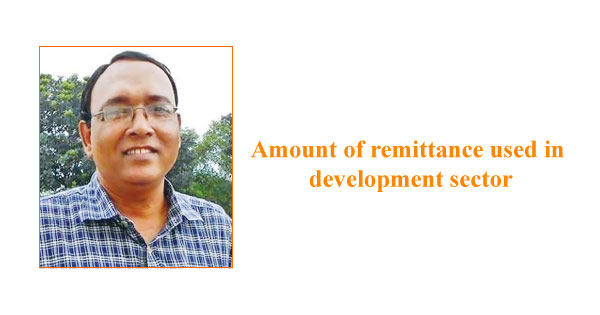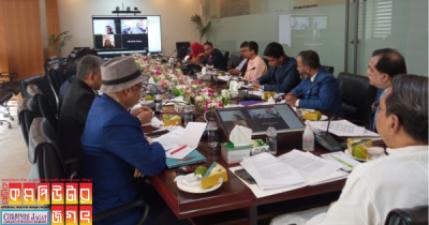Amount of remittance used in development sector
Three sectors have contributed a lot to the economic growth of Bangladesh, namely the garment, services and remittance sectors. Generally, we identify garments as the highest foreign exchange earning sector. Excluding the cost of importing raw materials for the garment sector, net foreign exchange earnings from remittances sent by migrant workers are three times higher than for garments. It is six times more than foreign aid flowing into the country and twelve times more than foreign direct investment. Therefore, it is not difficult to say that the remittance of expatriate workers is keeping the wheels of the country moving.
Although there has been a kind of stagnation in the number of migrants going abroad in the last few years, migration has increased in 2021-22 compared to previous years. However, it is difficult to say exactly how many are currently abroad as it has not been possible to develop a system to collect information on returning migrants. Along with male workers, the number of female workers has gradually increased. Due to legal immigration, the position of women workers in the country of immigration is much better than before. Even then, it has not been possible to completely stop harassment or sexual harassment of women workers abroad.
Both male and female workers in Bangladesh mainly participate in the unskilled labor market. Men work more in the construction, cleaning and service sectors. While some women work in garments, most women work as domestic workers. Remittance is one of the sources of foreign exchange in Bangladesh. These remittances are sent by Bangladeshi workers working in different countries of the world. Bangladeshi citizens abroad also include the middle class and a few others. The middle class is engaged in various professions abroad. Among them are doctors, engineers, teachers and professors and other professions. People of these professions abroad earn satisfactory income. However, the remittance that such professionals send to the country is only a fraction of the total remittance income. The income earned by the expatriate workers is by no means satisfactory. There are allegations that due to a lack of proper bargaining, Bangladeshi workers working abroad get lower wages than workers from other countries.
Along with expatriate men, expatriate women are also playing an important role in the economy of Bangladesh. The journey of women workers abroad started in 1991 by sending 179 women workers abroad. According to the Bureau of Manpower, Employment and Training (BMET) of the Ministry of Expatriate Welfare and Foreign Employment, there are currently 1 crore 27 lakh 44 thousand 577 expatriates in 169 countries, including about 1 million women workers. Every year more than 2 million men and women are added to the labor market of this country with a huge population, but the employment rate is very low compared to this. As a result, we are forced to think of some sort of labor migration. A survey found that women are ahead of men in remittances. Because they send almost all of their income to the country.
Bangladeshi women are also now working as migrant workers. The number of women workers working abroad is not very small. The experience of women working on foreign soil is also not pleasant. A large proportion of expatriate women go to the Middle East as domestic workers. Since 2014, a large number of women workers started moving to Saudi Arabia. These women workers also go to countries like United Arab Emirates, Jordan, Qatar, Lebanon etc. Besides increasing the cost of emigration, they are also being cheated abroad due to dishonest syndicates.
Because the middlemen have to pay huge amounts of money. But despite spending so much money and making so many sacrifices, they are suffering from various problems. Women who go abroad as laborers are not very educated and unskilled due to which those who do not have other qualifications and skills are forced to work as domestic workers in various households. They have to work long hours as there is no specific contract, no leave system. They are not paid properly, meanwhile many women are subjected to physical abuse for the slightest deviation from work. Many women are intimidated or lured into immoral relationships and sexually assaulted.
State embassies are established abroad to provide various facilities and protect the interests of the locals. But many women workers cannot file a complaint at the embassy if they are victims of abuse. Many of them hesitate to complain for fear of embarrassment.
The role of remittance in the economy of Bangladesh is very important. The money sent by expatriates is considered one of the catalysts in the socio-economic development of the country. The discussion on the role of remittances in the development journey and economic growth of Bangladesh in the last five decades is therefore much more relevant and necessary. However, due to the mismatch between the demand and supply of the labor force in the domestic labor market, the expatriate labor market is considered an important hub for our labor force. However, it is undeniable that as the remittances of migrant workers are strengthening the macroeconomic base, their remittances are also playing an important role in poverty alleviation, food security, child nutrition and education.
However, Bangladesh still faces a problem in bringing the money earned by expatriates. Migrant workers in Bangladesh are more comfortable sending money through informal channels. As we know, hundi refers to the illegal transfer of assets outside the international or national foreign exchange transfer framework. Organized groups in cities like London, New York, Dubai, Kuala Lumpur and Singapore conduct hundi activities in Bangladesh or other regions. At one time most remittances came through informal channels. However, later on, due to the infrastructural development in rural areas, the number of remittances sent through formal channels increased or the situation improved somewhat. Although the use of formal channels for remittance transfer has increased, the problem remains.
In order to understand the impact of remittances on the development of Bangladesh, its impact on both the short and long-term socio-economic factors can be assessed. Remittances act as an important catalyst in reducing poverty and financial development, especially in developing countries. Most of the expatriate workers have spent their days without employment in the country, they are working abroad. However, this may limit or create fewer employment opportunities for others in the home country. On the contrary, the remittances they send can also help create new jobs. But this happens only when remittances can increase national savings, capital and investment. So, we can say that remittances can play an important role in the development of developing countries both indirectly and directly.
According to the household survey data of 2016, it can be seen that at least one member of 8.27 percent of expatriates or immigrants. It is natural that the rate of migration from rural areas is higher than in urban areas. It can be seen that 68.44 percent of the remittance money sent by the villagers is spent on the purchase of daily necessities. In addition, 27.98 percent of remittances are used in various investments, 2.13 percent in various durable goods and the rest in savings (BBS, 2019).
The importance of remittances sent by migrants in the development dynamics of Bangladesh has been revealed in various statistics. Comparatively, villages with migrants have lower poverty rates and higher food and non-food expenditure. On the other hand, the average monthly consumption expenditure in households where there are no migrants is 3 thousand 209 taka. And the cost of food is 1 thousand 680 taka. The monthly consumption expenditure of the households where there are expatriates is 5 thousand 403 taka. Food cost 2 thousand 345 taka. Naturally, with this topic, we can understand the impact of remittances on rural economies and families. Migrant remittances play an immense role in poverty alleviation and achieving food security.
Migrant remittances not only improve the socio-economic position of their own households but also have multi-dimensional effects on the entire rural economy, which naturally plays a special role in accelerating the wheel of the rural economy. However, in addition to daily necessities, migrant families invest more in education or health. As a result, remittances play a role in education, skills and overall human resource development in the long term. For example, according to the household survey data of 2016, the average annual expenditure on education in immigrant households is Tk 25,797. This number is only 16 thousand 222 taka for other houses where there are no migrant members.
The writer is a researcher and columnist







.png)






০ টি মন্তব্য